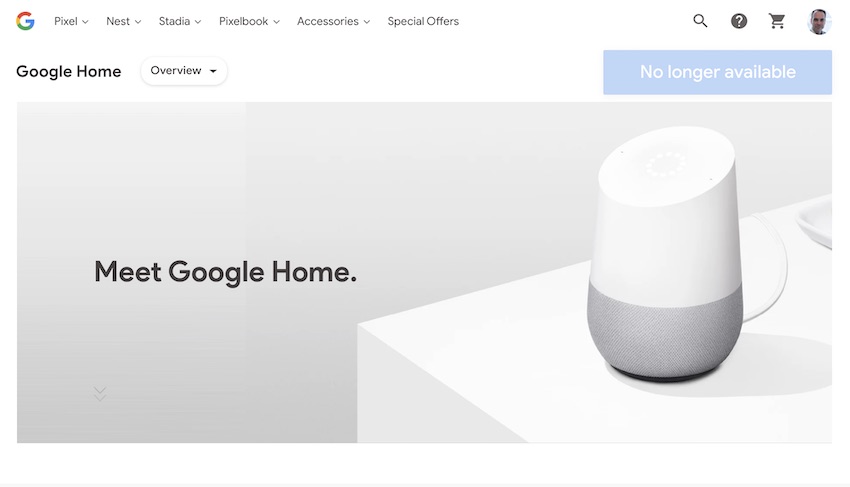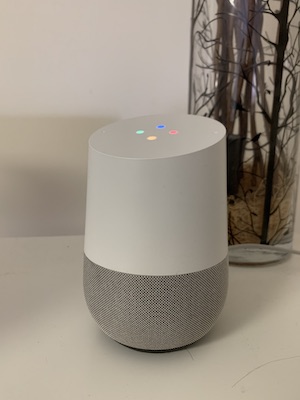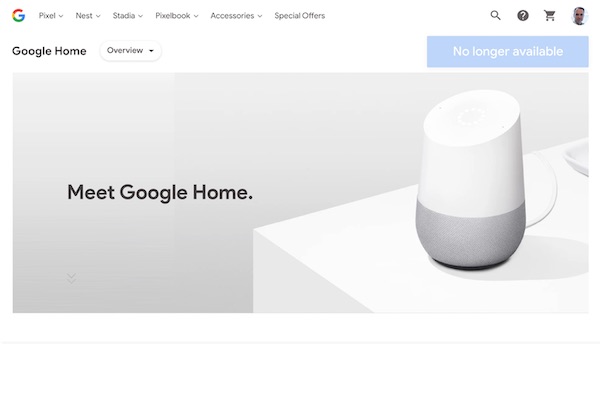Google Home No More
It’s the end of an era. Google Home was the first Alexa alternative in the U.S. smart speaker market created by the Amazon Echo. The device was announced in October 2016 and began shipping the following month. It began shipping almost exactly two years after the limited release of the original Echo. However, as of today, Google Home is listed as “no longer available” on Google’s website.

There are some retailers that still have Google Home in stock. Walmart appears to be selling its final inventory at a nice discount of $67 compared to the previous $99 list price. The device apparently is no longer available in stores, but you can order online and receive it by Friday. A few others such a Kohl’s seem to have inventory but Best Buy looks like it is sold out.
Google is giving away Nest Home Mini smart speakers this week.
Google Assistant adds Voice Match for voice purchase verification.
Building Your Nest
There is not necessarily a performance reason to discontinue the Google Home. It still works very well even 3.5 years after its launch. However, there is definitely a branding rationale behind bringing out a new device. At Google I/O 2019, the company announced it would rebrand the Home smart device product line to carry the Nest Brand. The Google Nest Hub Max smart display was the first to launch under the new branding. Google went to the trouble to adding stickers to Google Home Mini and Google Home Hub inventory with their new naming convention of Google Nest Mini and Google Nest Hub. The latter of which actually rebranded a couple of weeks prior to the official announcement. However, the company never touched the Google Home devices and they kept selling under the original name for a year after the rebrand was launched.
We speculated last year that there were both organizational and product focus reasons for the rebrand. From an organizational standpoint, consolidating physical products for the home under a single organization is logical. For the product, the Nest branding ties Google’s smart speakers and smart displays more closely with smart home use cases. That is clearly a popular utility for voice assistants and in theory could boost both the smart home and voice assistant-enabled products —- yes, synergy.
Performance Upgrades on the Horizon
It seems likely a new Nest Home will be introduced imminently. However, it is not a guarantee. The Nest Home Mini addresses many use cases of the original Home and Google has an incentive to direct users more to its screen-based smart displays that have comparable or better sound quality and provide more differentiated access to the company’s many visual-first services. The Nest Hub is also only about twice the size of the current Home model.

My Google Home from November 2016
With that said, it seems like a mid-range device is an important fixture in the category. My best is that we see a new device introduced shortly. It likely would have been announced at Google I/O with shipments starting in June. Without the big stage of Google I/O to amplify the messaging, it seems likely it will be announced when the new Nest Home is actually available for purchase.
Will a new device have performance upgrades? Almost certainly. The two most likely updates will be enhanced sound quality and more on-device memory and processing power. Yesterday, Voicebot reported that Google recently enabled limited voice purchasing confirmation via Voice Match. According to Google support documentation, the architecture of that service stores the voice identification model on the devices and only goes to the cloud when needed for verification after which it is deleted. This is a privacy and security feature and might improve processing speed for other services that don’t require cloud-based validation such as calendar or email access. Given that direction and Google’s demonstrations about on-device Assistant operation to Google I/O 2019, I suspect the new Nest Home will tout more on-device processing. Google is likely to highlight both the performance and privacy benefits of this change.
Google Home’s Promise and History
I began writing about Google Home in October 2016 before its official announcement. My first piece suggested that observers look for four key elements in the announcement to get a sense of what Google thought was important in the category as of October 2016.
- It’s about more than the Home
- Integration with Other Apps Used Throughout Your Day
- Integration with Visual Media
- The Price Point Question
Let’s assess that pre-launch prediction and what’s happened since. “It’s about more than the Home.” I think this was mostly right. From the beginning, Google has touted the differentiation for the Assistant as being in the home and available through billions of smartphones so it could be everywhere with you. That started with Google’s Pixel in the fall of 2016 and moved quickly to hundreds of millions of Android smartphones in February 2017. In August 2017, Google also forced all Google Actions to support both the smart speaker and mobile devices under threat of certification removal. The rebranding to Nest could be seen as reverting more to the home but Google’s story is far more about the Assistant than devices.
“Integration with Other Apps Used Throughout Your Day.” Google has certainly promoted integration with email, maps, YouTube, smart home, and other features that were apps before they were connected through the Assistant to smart home. However, they don’t really play that up too much. That may be because these use cases with the exception of smart home are not among the most popular on smart speakers. Google is clearly moving in that direction with App Actions announced at Google I/O 2019, it was a talking point at launch and was a bigger deal in 2018 with the Home Hub launch, but app integration has not been a big selling point to date.
“Integration with visual media.” Google is clearly moving in this direction but progress has been slow. Google Home has connections through Assistant with many smart TV and set top boxes and there are the smart displays. Google also introduced Interactive Canvas in 2019 which enables multi-modal voice-interactive experiences. Again, not much progress on this to date in terms of clearly differentiating Google in the eyes of consumers.
“The price point question.” Google did come out with more aggressive pricing than the comparable Echo product, originally at $129. That move forced Amazon to reduce its pricing. It did, however, take another year before Google introduced the Mini to compete head-to-head with Amazon Echo Dot in the sub $50 value segment. Price and discounting have consistently been important factors in the smart speaker market.
Google CEO Sundar Pichai said at the launch that with AI in general and Google Home in particular that, “We want to help you get things done in your world.” That’s been aa consistent theme right along. I suspect the Nest Home if it arrives, will double-down on that imperative.
Shoutout to Rita El Khoury at Android Police. We saw it initially elsewhere but believe Rita had it first.
Follow @bretkinsella Follow @voicebotai
Nearly 90 Million U.S. Adults Have Smart Speakers, Adoption Now Exceeds One-Third of Consumers
The Google Home Hub is Being Re-Branded to the Google Nest Hub









